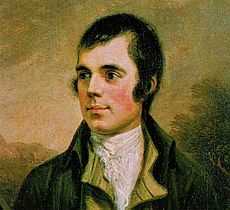Robert Burns Memorial (Barre)
The Robert Burns Memorial is a granite monument located in downtown Barre, Vermont. It was erected by Barre's Scottish immigrants in 1899 in observance of the 100th anniversary of the death of the Scottish poet Robert Burns.
About
The statue was conceived and modeled by J. Massey Rhind. It was one of his best works. James B. King of Milford, N.H, modeled the four panels. Sam Novelli carved the statue at the Barclay Brothers granite firm. Elia Corti, a native of Italy, carved the beautiful panels. Both were among the greatest sculptors of their time.
The monument itself stands 22 feet and 4 inches above the foundation, and ss statue is 9 feet and 4 inches in height. One of the principle features of the monument is the carved panels, which are in high relief. They depict scenes from three of Burns’s famous poems, The Cotter’s Saturday Night, To a Mountain Daisy, and Tam O’Shanter’s Ride. The fourth panel shows Burns’s cottage in Ayr, Scotland.
The Statue
The whole statue represents one of the finest works in granite. There are no bronze tablets on the monument. Every inscription and illustration is of Barre granite. The statue is itself shows the poet returning from his day’s toil, dressed in the garb of a ploughman, sleeves rolled up, bareheaded, his coat on his arm, eyes on the ground, and with the attitude and expression of thoughtful meditation.
- Front: The Cotter’s Saturday Night – “From scenes like these old Scotia’s grandeur springs.”
- Right: Tam O’Shanter’s Ride – “Ae spring brought off her master hale but left behind her ain grey tail.”
- Left: To a Mountain Daisy – “Wee, modest, crimson-tipped flow’r; Thou’s met me in a evil hour.”
- Back: “Burns’s Cottage”
History
Scottish immigrants erected Barre’s most famous monument in 1899 in observance of the 100th anniversary of the death of the Scottish poet Robert Burns. The statue and panels were carved by two of Barre’s finest Italian stone carvers, Samuel Novelli and Elia Corti, after models by Scottish sculptors J. Massey Rhind and James B. King.
On July 21, 1896, the Robert Burns Club of Barre, fifty in number, met to commemorate the centenary of Robert Burns’s death. The Burns Club, organized in January 1890, was a social and literary group whose purpose was to honor the name of this Scottish poet. It was at this meeting that the erection of an inspiring monument to Burns was advocated. It was felt that since Barre was thought of as the “Granite Center of the World” the monument should be the finest work of granite the world had yet produced.
By the anniversary of Burns’s birth, Jan. 25, 1897, plans were well under way toward this goal. Money was raised by generous gifts from admirers of Burns throughout Vermont, but largely though the generosity of the people of Barre.
On July 21, 1899, the anniversary of the poet’s death, dedication ceremonies were held and attracted one of the largest groups of people assembled in Barre. Among those who attended the ceremony were military and civic organizations, honored guests and Miss Florence Inglis (later Mrs. Ernest Tremblay) dressed and crowned as the Scottish Muse. She drew a cord and unveiled to the admiring public the statue of Robert Burns on a pedestal of unsurpassed beauty.
References
- "The Robert Burns Memorial." Informational Handout. Vermont Historical Society. October 2011.
- "Story of Barre's Robert Burns Statue" Vermont Historical Society
- Barre's Downtown Walking Tour
- Robert Burns Around the World
- Northfield News "110th Anniversary of Bobby Burns Monument"
- "History of the Burns monument and unveiling ceremonies, Barre, Vermont, July 21st, 1899." Burns Club of Barre. Published by The Burns Club, 1899. ISBN
| |||||||||||||||||||||||||||||
Coordinates: 44°11′47″N 72°29′56.7″W / 44.19639°N 72.499083°W
